After returning from our expedition in Portland we met up with our group of 31 Road Scholars, two guides, Carol & Lynn Unser, and one bus driver, Robert. To our delight there was a couple in the group that we had gotten to know on our New Zealand trip: Helene & Mel. We were given an orientation to the entire trip, complete with disclaimers about the eclipse: no one was sure WHAT was going to happen on the ground. The only sure thing was that the sun & moon would put on a spectacular show for those who could see it. We hoped we would, but nothing was certain.
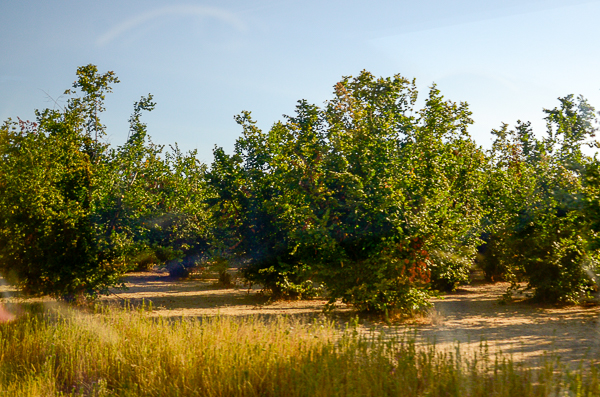
This is not a very interesting picture, but it has a story to go with it. These are filbert trees. When we first began to visit Oregon back in the 1980s, we developed a taste for Oregon wines. They weren't readily available back east, so we would have wines shipped from the wineries. At that time it wasn't legal to ship wine across state borders, so the shipments always came from The Filbert Farm! The shipper either didn't notice or didn't care that the "filberts" gurgled.
It took a Supreme Court decision to overturn protectionist wine shipping bans.
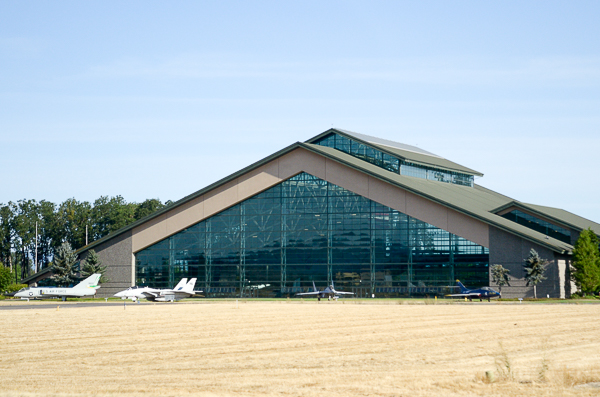
I was sorry that we didn't have a chance to stop at the Evergreen Aviation & Space Museum, which is the current home of the Spruce Goose, among other planes. The plane is indeed made of wood (birch, not spruce). It was flown only once (briefly), with Howard Hughes at the controls.
This hangar was purpose-built for this enormous plane. The size can be compared to the several fighter jets in front.
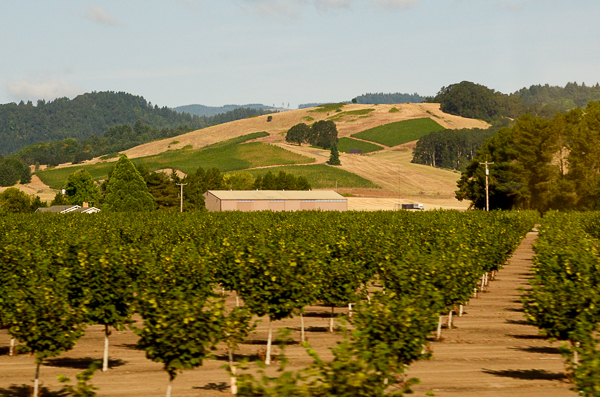
As we passed through McMinnville we saw many vineyards and orchards. Our favorite winery in this area was Eyrie Vineyards, which was always on our tasting schedule. Founder David Lett was the primary mover behind establishing Oregon wines on the world stage. He was an interesting guy (he once tried to steal Jim's fountain pen -- at least he threatened to), and we think the Eyrie wines haven't been the same since he died.
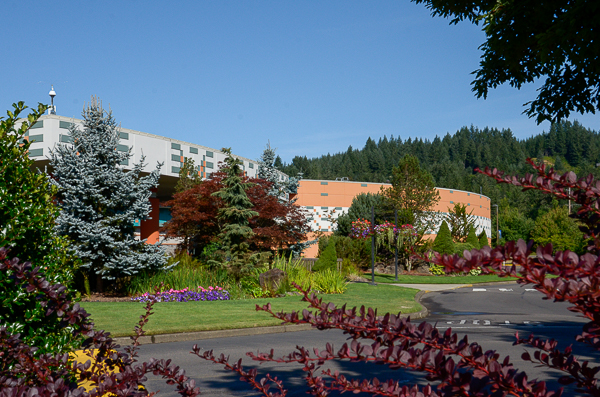
We stopped for a bio break at the casino run by the Confederated Tribes of Grande Ronde. Carol explained how, in spite of the numerous acts of injustice toward the native people by European immigrants, the various tribal councils have been some of the largest benefactors of the state education system and have also been instrumental in helping their neighbors in times of natural disasters such as fires and floods.
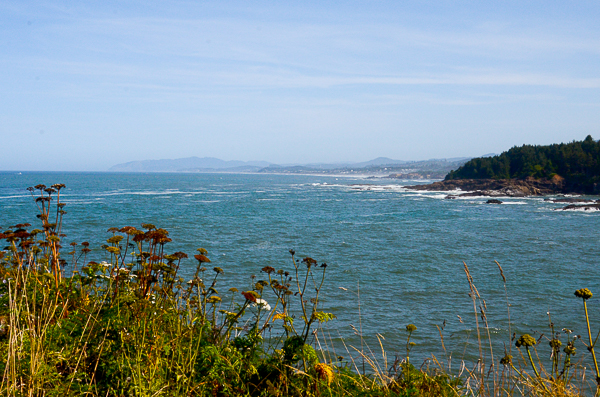
We stopped at the Rocky Creek Viewpoint (of the aptly named Whale Cove) to keep an eye out for whales. The headland in the far distance jutting out to sea is Cascade Head. Carol explained that the rocks composing this headland are volcanic basalt that originated from an ancient volcanic flow (~16 million years ago) in what is now southeast Oregon -- over 300 miles away. Many of the headlands we saw had the same source.
The source of this eruption was the hotspot that is now located under Yellowstone Park in Wyoming. The westward movement of the North American tectonic plate has carried the land farther west. Click to see a map of the track of this hotspot.
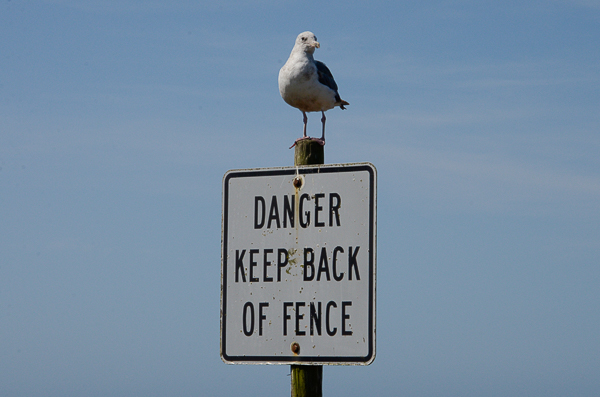
This seagull seems to have appointed him/herself guardian of the area.
By the bye, I told Carol at the time and it is worth repeating here that although I've heard talks and presentations by many geologists over the years, she was the first geology teacher I had ever heard. She makes the subject vibrant!
We were treated to views of more than one gray whale at this overlook. Although most migrate from their breeding grounds off Baja California to their summer homes near Alaska, Carol & Lynn told us that many stop off along the Oregon coast -- particularly mothers with small calves.
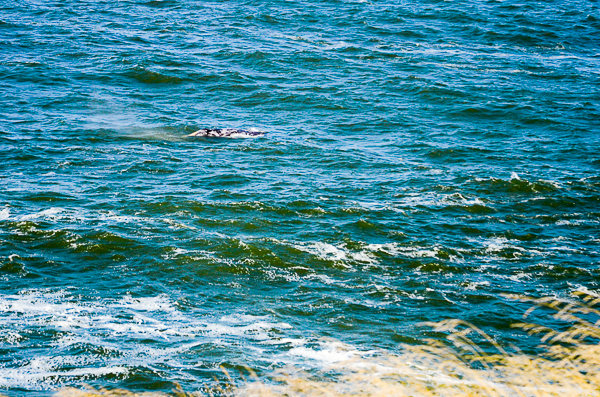
A whale can been seen here. The feeding isn't as rich as it once was along this coast. The huge kelp forests that supported the tiny creatures they eat have largely disappeared following the demise of the southern sea otter, which was hunted to local extinction in the early 20th century.
There have been isolated sightings of sea otters in the area, but a reintroduction program in the 1970s failed. Lynn said that were they to return there would be major disruption of a Dungeness crab fishery that has become established once the kelp disappeared. Everything is connected to everything else!
Ocean acidification due to higher levels of carbon absorption may be a greater threat to the fishery than returning otters, however.
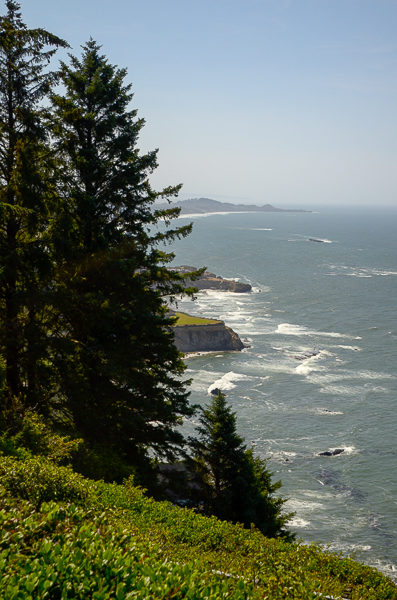
We continued south along the rugged and spectacular coast. The dark basalt rock betrays its volcanic origin.
We are seeing the "leading edge" of the North American plate. This plate is moving to the west and colliding with the small Juan de Fuca plate, which is moving east. The Pacific plate in turn is moving to the northwest. Together they make for some interesting landforms. Click for an interesting discussion and some pretty cool animations. (At last check many of the animations weren't available due to an unsupported plug-in, at least on the Edge browser.)
The Cascade volcanoes, which are much younger than the hotspot volcano that created these basalt flows, are the result of the subduction of the Juan de Fuca plate under North America. We will be visiting them later in the trip when we see Crater Lake, the caldera of an extinct volcano.
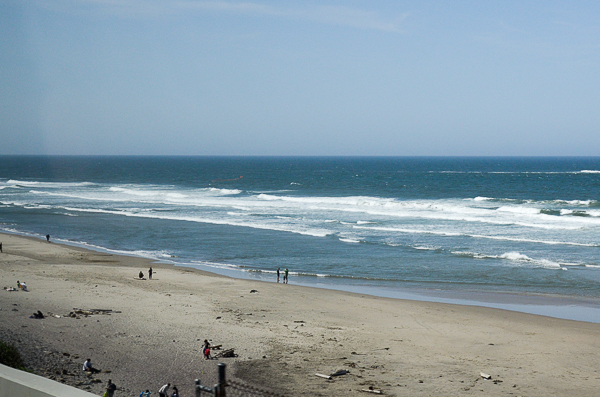
In between the headlands were many glorious and uncrowded beaches. The ocean is relatively calm at this time of year. In the winter the fierce storms whip up much larger waves.
You don't see anyone in the water because it is very cold. Sometimes there are surfers using the beaches, but they wear wetsuits! In the Newport area, which is where we are now, the average ocean temperature for September is 55°.
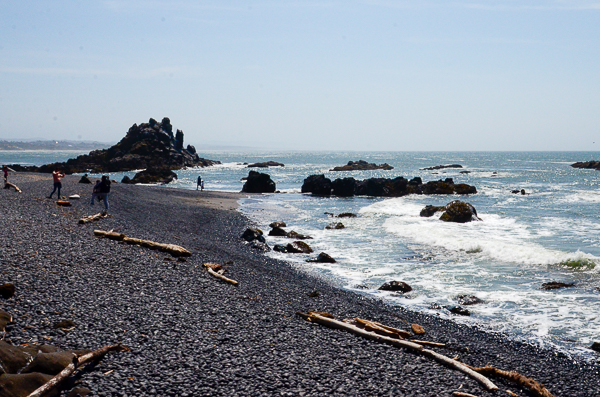 Our
next stop was at the Yaquina (pronounced like ya-KYNE-a) Head lighthouse.
There was a stairwell down to the "beach," which was composed of basalt
cobbles rather than silicon sand. Walking on these cobbles was not easy,
but I escaped without a twisted ankle.
Our
next stop was at the Yaquina (pronounced like ya-KYNE-a) Head lighthouse.
There was a stairwell down to the "beach," which was composed of basalt
cobbles rather than silicon sand. Walking on these cobbles was not easy,
but I escaped without a twisted ankle.
A view of the lighthouse. One advantage of seeing the lighthouse from the beach is that I'm sheltered from the ferocious wind coming from the other side of the point.
We saw whales here too.
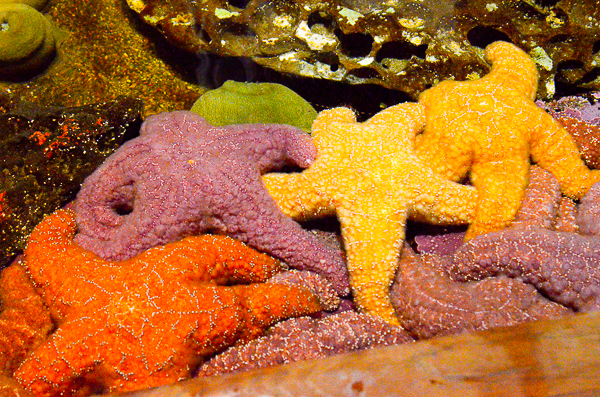
Another stop that day was the Oregon Coast Aquarium. These colorful sea stars were only one exhibit. There were birds and fish and even a shallow tank where you could "pet" the exhibits -- carefully and respectfully of course.
Click to see more fishy pictures and birds too.
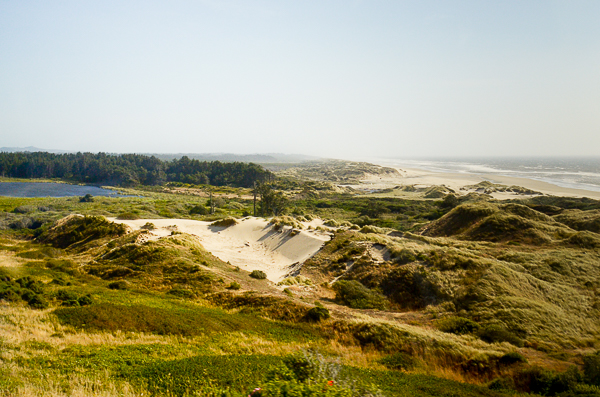
Florence is at the north end of the Oregon dunes. This unique ecosystem has been drastically altered by the decision to import European beach grass to stabilize the shifting sand. It not only stabilized the dunes, it opened them to colonization by other vegetation including shrubs and trees. This picture shows how the grass has overrun the dunes. There will be more explanation on the next page.
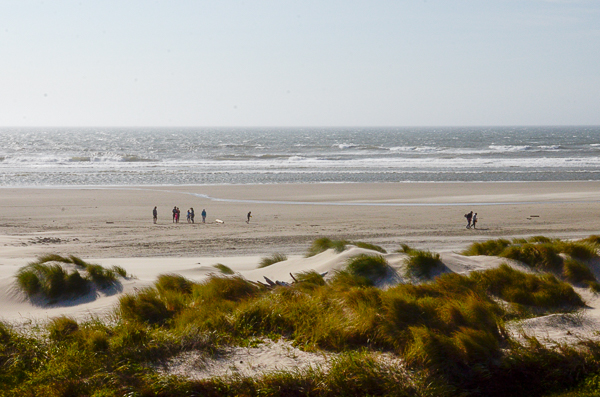
The view from outside our room at the Driftwood Shores in Florence, where we would spend the next two nights. Carol said that this is one of the few places were the native dune grass can still be found.
Click your "back" button to return to the previous page or click for our picture album.